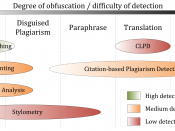Over a third of high school and middle school students agree that college is so important, they would be willing to cheat on a test to get into one (Gomez, 2001). If this is the mind set of those entering a traditional school, what can be done about reducing dishonesty in online universities? This paper will examine the problems with plagiarism, the consequences, how it is done, the differences between online and brick and mortar schools, and the solutions to the problem of plagiarism.
Online universities have some unique problems with dishonesty and cheating. How can it be fixed? What are the methods and technologies available to detect plagiarism? And, most importantly, how can students learn that plagiarism is in all actuality, theft; theft of ideas. Students who plagiarize are no different than pickpockets, muggers, and car thieves. Also, the students themselves are robbing themselves of their own self image and a quality education.
Plagiarism is not victimless. To start, it is necessary to define the word plagiarism.
Plagiarism, as defined by the Merriam-Webster dictionary, is to use one person's work as theirs (Plagiarism, 2008). In today's age plagiarism is a computer away. There is a concern that high school and college students are not crediting their research properly. There could be a lot of reasons why. It could be that the students don't know how to properly credit their sources or maybe they do not want to. For those who do not want to credit their source, they do not understand the consequences. Plagiarism is stealing. It is the same a stealing a wallet or a purse. The only difference with plagiarism is that a person does not have to look out for the owner of that wallet or purse to catch them. With plagiarism a person can steal...


